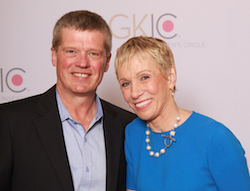One time, a few years ago, I called one of our very good clients who has a brick and mortar store, excellent mail order business, superb telemarketing organization, and a top notch website. They don’t have a retail store in my area, so I usually order online or call them.
I order from them for a number of different reasons:
- They area a very good client of ours.
- Their products are superb.
- Their service is almost always at the Make-You-Happy level.
- But even the best service businesses fall short and that’s why we need to be consistent and persistent in reinforcing Out-Nordstrom Nordstrom Customer Service in our business.
One of the areas that continually amazes me is how often people assume they know what you are going to ask and therefore don’t really listen to what you’re saying. I had ordered top quality expensive wading boots for fly fishing in rivers. When I got them they were too narrow. I looked through their catalog and saw that the only boot they had in the catalog was available in wide widths was a lower price model. Now, I’m not snobby, but my feet are old enough that I need the support and extra sole thickness.
I called the 800 number to ask if they had any higher quality boots in wide widths. A very nice good customer service person told me that was the only boot that actually came in a wide width, but suggested that I call back in the morning and ask for a “boot product specialist” and see if one of the boots “ran” wider than the model I ordered.
I thought that was a great idea! I buy New Balance tennis shoes for that reason. I don’t need to get a “wide,” their shoes just run “wider.”
So I called back the next day and asked for a product specialist. I told him that I had already found out that the only boot they carry in a wide was their inexpensive model and that the customer service person suggested I call back to see if any of the more expensive models “ran” wide and might work for me.
He said, “Let me check.” It was quite a long while so I thought he was “checking” with someone else to see if any of their boots “ran” wider. But then I heard him mumbling on the phone. I found out that he was just reading from the catalog.
I told him I had already read the catalog and that I knew none of the other boots came in wide widths and ask again if he or anyone there knew of any brands “ran” wider. He just went back to reading the catalog. Finally, I just said, “Never mind,” and hung up.
I went to the local fly shop that is not very convenient for me to get to and found that they didn’t have any boots that came in wide widths either. But they did have a great boot that ran wide. I bought a $139.00 pair of boots.
And yes, you guessed it. The company I called in the first place has the same boot.
The “product specialist” was very nice and polite and I’m sure he had customer service training. The company’s customer service is consistently too good to think it just comes about without training. There are at least 11 lessons to learn from this one call.
- Train your team to truly listen. Pay particular attention to people in your organization who tend to answer questions from you and others before they listen to the entire question. Pay particular attention to those who like to finish questions for others. Truly listen, don’t assume that you know what someone is going to say. You know what happens when you assume. You make an ass out of u and me:
ass-u-me.
- Monitor your customer service. This seems almost obvious, but while it’s obvious, almost no one does it. Whether you use secret shoppers, your own people secret shopping, or recordings, don’t ass-u-me that your people are doing what they’ve been trained to do. And don’t ass-u-me that they do the same things when you or a manager are around to witness it firsthand.You surely can’t monitor every customer service interaction, but in this case, over time the business I called would certainly hear a similar customer service interaction and be able to address it in their training.
- Make sure your customers know what to do when they are not being served properly. Be sure your customers know your exceptional customer service expectations. They need to not only know your exceptional customer service expectations, they need to know what to do when they don’t get Out-Nordstrom Nordstrom Customer Service.In as many ways as you can tell your customers what to do when they don’t get Out-Nordstrom Nordstrom, Make-You-Happy Customer Service. Tell them when they are on hold on the phone. Tell them in any communication that you send to them. Tell them with signage.At American Retail Supply we tell customers to please let us know if we even let you down and if you’re still not happy call me, Keith Lee the owner of the company at 253-859-7310.If I have been told, “If we ever let you down, please call Bill at xxx-xxx-xxxx” I would have likely called Bill who would have found out that they do have a great brand that runs wider. They would not have only thrilled me, they would have me writing an entirely different story about their Out-Nordstrom Nordstrom Customer Service and I would have told you their name and I would have spread a huge amount of positive word-of-mouth advertising.
- Know your product. I’m not going to harp on this too much because we are human and we can’t know everything. But I do think that a “boot specialist” certainly should have known if any of hte brands “run” wide. And if not he should have been trained to do #6 below.
- Know your Customers. I am a very good customer for the company I called. Good enough that they send me a hardback version of their master catalog that is about an inch-and-a-half thick.I certainly believe in giving every customer World Class, Exceptional Customer Service. With that said, your best customers should be taken care of even to a higher degree. Yes, the customer that buys a $200,000 a year from us does get super-duper Out-Nordstrom Nordstrom Customer Service. But you say, “How can they know that you’re a great customer?” Have a great data base! I’m going to be blunt here. With the price of computers and software today, there is simply no excuse for not knowing who your great customers are and you are throwing money away by not marketing to and treating them differently and that certainly should not affect giving your other customers Out-Nordstrom Nordstrom Customer Service.In this instance, the product specialist should have pulled up my account, saw that I was one of their best customers and done something special to take care of me. What could he have done? He could have called someone in the company that knew my answer and called me back. He could have called his manufacturers and called me back. He could have gone to the warehouse and tried on some boots to see if any “ran” wide. He could have done something.Should he have done those things for someone who buys $3.95 a year? Maybe, maybe not. But for one of his best, absolutely!
- Train people to know where to go to get answers. I covered this a bit in #5. There are a lot of things he could have done to answer my question, but the biggest frustration was that he never seemed to listen well enough to hear the question properly. We have a lot of product at American Retail Supply. Regardless of how much training we give our team there is absolutely no way our reps can know everything when we put them on the phones. So we spend a lot of time in our training teaching them where they need to go to get the answers. When they start we constantly remind our reps of the most important sentence to learn: “I’m sorry, I don’t know, but I’ll find out and get back to you by…” and then get back to them when you told them you would.
- Create loyal customers. In this instance, one of my favorite places to shop let me down. But that’s unusual. Their service, products and delivery are usually superb and because they are, I’m loyal and I’ll continue to shop with them.
- You can learn multiple lessons from poor customer service in your business. The normal response to bad customer service is to simply blame the person who delivered the poor service. As you can see by the ten things we learned from this one phone call, you can learn a great deal from one instance in poor service and there are lots of things that could have been done so that this didn’t happen. It’s not just the reps fault.
- If you truly believe in and practice Out-Nordstrom Nordstrom Customer Service you will have multiple ways to catch and fix poor customer service. When you implement Out-Nordstrom Nordstrom Customer Service you have many ways to identify, catch, and fix service that is less than exceptional. With Out-Nordstrom Nordstrom Customer Service you will have opportunities to recognize problems, fix them, or maybe not even have issues come up because of
- Training
- Monitoring
- The customer contacting someone else
- Product knowledge
- Customer knowledge
- Training your Team to know where to get answers.
- Three fingers pointing back at you. I learned a lot of wonderful lessons from my mentor, Dick Thompson. One of them is, “Remember, when you point your finger at someone else, three fingers are pointing back at you.” If customer service in your business is anything less than great you have one person to blame… yourself! There are only a few reasons for poor, or great customer service and you are responsible for all of them.
Be sure to have your eyes and ears open for your own customer service stories and them lessons you can learn from such experiences!
-Keith Lee

